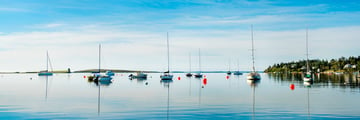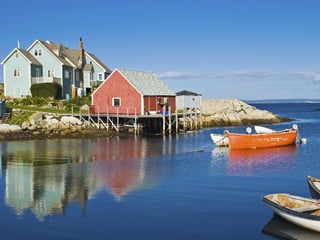A photogenic tour of stunning Atlantic Canada
Read time: 7 mins
Atlantic Canada includes The Maritimes: Prince Edward Island, Nova Scotia and New Brunswick, as well as Newfoundland and Labrador. This area is so incredibly scenic, it’s ideal for photographs and anyone who wants to capture lots of postcard-perfect photos. These breathtaking sights are musts for the ultimate photogenic tour through the region.

Nova Scotia
Peggy’s Cove - Peggy’s Cove is home to Peggy’s Cove Lighthouse, the most famous lighthouse in the country. First lit in 1915, it marks the eastern entrance of St. Margaret’s Bay with the image of the ocean crashing against the massive rocks it sits atop becoming iconic ever since.

Old Town Lunenburg - A UNESCO World Heritage site, this historic seaside village, just a short drive from Peggy’s Cove boasts colourfully-painted homes that make it especially photogenic. Combined with the horse-drawn carriage tours along the waterfront and the famed Bluenose II schooner on the harbour, it’s a true photographer’s delight.

Cape Breton Highlands - The Cape Breton Highlands are not to be missed for anyone who wants to enjoy magnificent scenery and bring home stunning photographs. One of the top ways to experience it is by driving the 185-mile-long Cabot Trail, considered one of the world’s most scenic drives. It completes a loop around the northern tip of Cape Breton Island, winding along seaside cliffs, immersing travellers in vibrant Acadian and Celtic cultures. You may even be able to capture photos of puffins, bald eagles, dolphins or whales. A visit to the island wouldn’t be complete without taking a selfie with the largest fiddle in the world, located along the Sydney waterfront where it welcomes cruise ships and their passengers.

Burntcoat Head Park - This park hosts the spots where the world’s highest recorded tides occur. It’s where the locals come all year-round to watch the tide come in or walk around the mud flats when the tide is low, leaving vast areas of the ocean floor uncovered. If you can, time your visit just before sunset and you’re guaranteed some incredible pics.
Five Islands Provincial Park - This park is home to some unique rock formations that can be seen when the tide is out.
Annapolis Valley vineyards - The Annapolis Valley province is home to some 18 wineries and over 70 grape-growers with most located in the lush Annapolis Valley. The vineyards make for gorgeous pictures, and you can also enjoy the unique flavours of Nova Scotia’s fabulous wines. Wolfville is considered the wine capital as one of the best places to start your exploits of the region.
Whale watching tours - You’re just about guaranteed to take lots of great pictures by joining a whale watching tour, with humpback, minke, pilot and finback whales commonly spotted along with other marine life like sea turtles, porpoise, dolphins and more. The best places for a tour are Digby on the Bay of Fundy or from Cape Breton Island.

Top of Cape Split - Take one of the most popular hikes in Nova Scotia, the Cape Split Trail and you can enjoy jaw-dropping views over the Bay of Fundy. Located in Cape Split Provincial Park Reserve, the route is a little over 7 miles round trip and leads to a grassy meadow overlooking the changing tides and the 3 Sisters volcanic sea stacks.
New Brunswick
Hopewell Rocks - Hopewell Rocks, also referred to as the Flowerpot Rocks, are rock formations that are especially impressive at both low and high tide, carved out by the raging waters. At low tide you’ll be able to get up close to them by walking on the beach, and a high tide you’ll see the bases of the 40- to 70-foot high pillars submerged. This is the focus of the New Brunswick Hopewell Rocks Night Photography Excursion, a highly recommended two-and-a-half-hour-long experience for all types of photographers who want to learn the techniques of night photography in one of the world’s most alluring settings. You’ll be able to shoot them silhouetted against the backdrop of a dark, starry night while learning more about the techniques of night photography from an expert guide who is highly knowledge about this area of the Bay of Fundy.

Fundy National Park - Located near the town of Alma along the Bay of Fundy, this national park is home to more than two dozen waterfalls, a rugged coastline, forest and lots of scenic trails. Some of the best waterfalls to capture include Dickson Falls, the most popular in the park, which can be views by taking a short, approximate one-mile trail that follows Dickson Brook. Third Vault Falls is the highest waterfall in the park at over 52-feet-high, accessed via a 5-mile roundtrip trail, with stairs in place to make it easier to traverse some of the steep areas.

Reversing Falls - This unique phenomenon on the Saint John River is a series of rapids where the river flows into the Bay of Fundy. At high tide, the rush of water forces its way up the river which causes it to run in reverse, with the rapids flowing against the current. One of the best places for a photo is from the Reversing Falls Bridge.
Grand Manan - Grand Mana is a fabulous place for shooting photos of lighthouses and unspoiled beaches as well as offering great kayaking, hiking and charming fishing villages.
St. George - This photogenic town is filled with enticing sights, but arguably the best is the view of St. George Gorge at First Falls with the red dam making it look as if it’s a painting come to life.
Kouchibouguac National Park - Located in eastern New Brunswick along the Gulf of St. Lawrence, this park offers a wealth of opportunities with barrier islands, sand dunes, forest, salt marsh and lots of wildlife. Just some of the creatures you might spot here include moose, black bears, coyotes, seals and birds.

Prince Edward Island
Prince Edward Island National Park - Located along the island’s north shore on the Gulf of Lawrence, stretching for about 40 miles along the coast, this park features beaches and sand dunes, wetlands and sand marshes that provide important habitat for all sorts of birds. The red sand beaches make for especially spectacular photos. Covehead Harbour Lighthouse is also located here and is easy to access and photograph.

Cape Tyron - One of the top spots to capture the most impressive cliffs on the island, here they rise nearly 100-feet from sea level.
Victoria Park, Charlottetown - Just across the harbour from Rocky Point, Victoria Park offers beautiful views of the harbour along with a boardwalk, walking trails and flowers.
Newfoundland
Jelly Bean Row - This street in St. John’s is a famous avenue lined with brightly-painted homes in a dazzling array of colours that follows the steep hills along Holloway Street overlooking the harbour where, in late spring and early summer, there may be sparkling white and blue icebergs floating in. The Victorian saltbox homes were originally constructed to provide temporary accommodation after the Great Fire of 1892, but have remained there, well-preserved, bring a joyful, cheery feel to the city even on the greyest days.
Quidi Vidi Village - Located just outside of the capital city of St. John’s, the unique fishing village of Quidi Vidi is one of the province’s most iconic sites, with lots of fantastic photo opportunities. One of the highlights is Mallard Cottage, a cottage and national historic site that lies next to the road, looking as if a breeze could easily tip it over.
Cape Spear - The easternmost spot in the western hemisphere, Cape Spear is a must-visit for any photographer. Arrive just before dawn and you’ll get to experience the continent’s first sunrise, one of the most beautiful in the world. Perched atop a cliff is the Cape Spear Lighthouse, the province’s oldest surviving lighthouse, flashing since the mid-19th-century. Watch the waves that crash against the shore and look for icebergs throughout spring and into early summer, along with the whales that come here to feed, typically about mid-June through mid-September.

Trinity - Arguably the most picture-perfect village in all of Newfoundland, and one of the prettiest in the world Trinity looks as if it were built to be a film set. And it has been the setting for several movies, perhaps most famously “The Shipping News.” As you come around the bend toward the town and it comes into view, there is a grassy hill that provides the perfect spot for capturing it from above. There are lots of other photo opportunities too, with Trinity steeped in history, including well-preserved 18th-century buildings and churches. Hiking trails lead to sandy beaches and viewpoints for spotting icebergs, whale, puffins and other sea birds.
Skerwink Trail - The Skerwink Trail is just north of Trinity near Port Rexton. It’s been chosen as one of North America’s and Europe’s top 35 walks by Travel + Leisure magazine. The 3.3-mile coastal trail is easily doable within a couple of hours and provides numerous scenic overlooks that include sea stacks, bald eagles and icebergs or whales, depending on the season. From the steep cliffs, you’ll be able to shoot photos of impressive rock arches and caves along the way.
Fogo Island - Fogo Island offers the chance to experience what feels like a completely different world. It’s home to 11 unique communities, each with its own distinctive character and endless sources of inspiration for visiting photographers and artists. In the traditional Irish village of Tilting, wander through the tall grasses and snap photos of the red-hued fishing huts, and discover Sandy Cove Beach, which looks as if it was stolen from the Caribbean with its clear turquoise waters – dip your toes in and you’ll soon realize you’re definitely in Newfoundland. Brimstone Head, which the Flat Earth Society says sits in one of the Earth’s “four corners” can be hiked to take in incredible vistas of the steep cliffs and the waters below.

Gros Morne National Park - The west of Newfoundland offers some of the most striking natural beauty, much of which can be found in this national park and UNESCO World Heritage Site. It spans across almost 700 square miles in the Long Range Mountains and is renowned for its freshwater fjords, dramatic waterfall-filled cliffs and wildlife, particularly moose, with one of the world’s highest concentrations of the animals found right here. You’ll also have the chance to witness unique and complex geology at the Tablelands, a flat-topped rock of mountain that’s usually only found deep within the mantle of the Earth.

Fishing Point Park, St Anthony - St. Anthony is located near the tip of Newfoundland’s Great Northern Peninsula. The drive there alone provides many great stops for pictures, in fact, it’s been called one of the most beautiful drives in Canada. Once in town, head to Fishing Point Park which features an unforgettable hike straight up 476 steps to the top of Fishing Point head where you’ll be surrounded by the sea on three sides Depending on the time of year, it’s one of the best places to see icebergs and whales.
L’Anse aux Meadows - About 40 minutes north of St Anthony at the northern edge of the peninsula, you’ll find North America’s only authenticated Viking settlement. This historic and archaeological site serves as the first known evidence of Europeans in the Americas. This was the very spot Norseman sailed to from Greenland, building a small encampment that was made up of timber-and-sod buildings more than a thousand years ago. It all sits against an awe-inspiring backdrop of rugged cliffs, coastline, and bog. You’ll be able to discover the fascinating archaeological remains of the Viking encampment that was declared a UNESCO World Heritage Site in 1978 - and take lots of fun photos too. Viking interpreters in costume offer a good glimpse of the period and will answer questions that you have while exploring places like the re-created longhouse and other buildings.

Labrador
One of Canada’s most remote wilderness regions can be accessed by ferry from Newfoundland, with the highlight the Labrador Coastal Drive. This southern driving route on the edge of the North Atlantic offers the chance to step into the shoes of ancient mariners and Native Americans while capturing lots of fantastic photos.
For the ultimate trip, visit Torngat Mountains National Park. Filled with mountains, icebergs, glaciers, caribou and polar bears, this is a place where the Inuit still fish, hunt and travel the same way they’ve done for thousands for years. The newest national park in the province, it spreads across 3,745 square miles of unspoiled wilderness, west from the Atlantic seacoast to the Quebec border, and south from Saglek Fjord to Labrador’s northern tip. As it’s so remote, it’s managed to stay nearly untouched by humans. There are no roads, signs or much in the way of facilities. Getting there requires utilizing the services of Torngat Mountains Base Camp, hiring a charter or joining a special tour – if you can do so, it’s sure to be an experience of a lifetime for photographers and non-photographers alike.

More Inspiration
Recommended holidays













